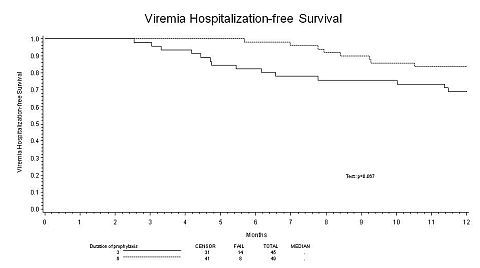Effect of Prophylaxis Duration on the Incidence of CMV Viremia and Hospitalization Rates in D+/R- Kidney Transplant Recipients
Medicine, Division of Nephrology, University of Nebraska Medical Center, Omaha, NE
Biostatistics, University of Nebraska Medical Center, Omaha, NE
Meeting: 2013 American Transplant Congress
Abstract number: A584
Purpose: In high-risk CMV kidney transplant recipients, the optimal duration of prophylaxis is unclear. We assessed the rates of CMV viremia and related hospitalization in D+/R- patients receiving 100 days of prophylaxis (100D) vs. 200 days (200D) with valganciclovir (VGC).
Methods: All adult CMV D+/R- recipients transplanted between 1/1/2008-9/1/2011 were analyzed retrospectively. Outcomes of 100D and 200D were compared; the primary endpoint was the development of viremia within 12 months of transplant. Secondary endpoints included rates of hospitalization due to CMV, costs, rejection, graft loss, and death.
Results: 45 subjects received 100D and 49 received 200D. Groups were comparable except for immunosuppression management. 100D group patients were less likely to receive anti-thymocyte globulin induction (20/45 vs. 43/49, p<0.01). Most patients received mycophenolate and tacrolimus, but more patients in the 100D group were maintained on prednisone (35/45 vs. 7/49, p<0.01). There was a significantly higher incidence of viremia in patients receiving 100D (21/45) compared with 200D (9/49) in the first year following transplantation (p<0.01). 12/45 subjects in the 100D group were hospitalized vs. 6/49 in the 200D group (p=0.11). Figure 1 depicts the interval from transplant to first hospitalization for viremia, showing a trend favoring 200D.

Additionally, 6 patients receiving 100D were re-hospitalized due to CMV, compared with 0 patients in the 200D group (p=0.01). Inpatient days for CMV treatment were 7.5 ± 7.98 (100D) vs. 6 ± 2.67 (200D) p=0.37, with associated charges being $55,000 ± 79,000 (100D) vs. $49,000 ± 24,000 (200D) (p=0.18). We observed no difference in rates of acute rejection, graft loss, or mortality between groups.
Conclusion: CMV D+/R- kidney transplant recipients who received 100D with VGC had higher rates of CMV viremia at 12 months compared with those who received 200D. We observed a higher rate of hospitalization and higher associated costs in patients receiving 100D.
To cite this abstract in AMA style:
Sia J, Westervelt J, Lyden E, Miles C. Effect of Prophylaxis Duration on the Incidence of CMV Viremia and Hospitalization Rates in D+/R- Kidney Transplant Recipients [abstract]. Am J Transplant. 2013; 13 (suppl 5). https://atcmeetingabstracts.com/abstract/effect-of-prophylaxis-duration-on-the-incidence-of-cmv-viremia-and-hospitalization-rates-in-dr-kidney-transplant-recipients/. Accessed December 22, 2025.« Back to 2013 American Transplant Congress
